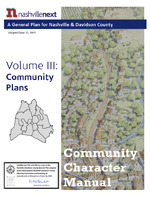 The Community Character Manual (CCM) is built around identifying the future character of an area, compared with its current character. Development character includes design elements like building size and height, setbacks from the street, and spacing. It also includes things like access, parking, and landscaping.
The Community Character Manual (CCM) is built around identifying the future character of an area, compared with its current character. Development character includes design elements like building size and height, setbacks from the street, and spacing. It also includes things like access, parking, and landscaping.
The Community Character approach to policy is based on the look and feel of neighborhoods, centers, corridors and open spaces. It sets general guidelines for the form of the built environment in seven different classifications, or "transect categories," ranging from untouched natural land to intense urban centers.
The manual has three main functions:
- To explain and institute the Community Character Policies that are applied in each Community Plan
- To help shape or preserve the form and character of open space, neighborhoods, centers, corridors, and districts within a community
- To provide direction for the creation and application of implementation tools such as zoning
These policies, and their transects, have a limited role in subdividing land. Transects determine which section of the Subdivision Regulations apply to a subdivision request to ensure harmonious development in light of a community's long-range vision. Community Character Manual policies are not otherwise referenced during subdivision review.
The manual is a living document, and can be amended to reflect the community's changing needs and goals. It was originally adopted by the Planning Commission in 2008, amended in 2012, updated in 2015 as part of the creation of NashvilleNext, and reorganized/streamlined in 2017 with the update of NashvilleNext.
